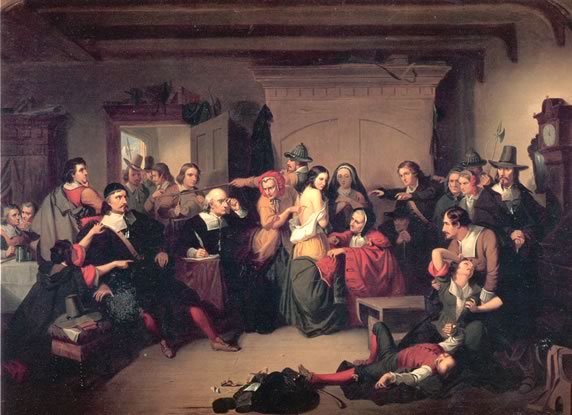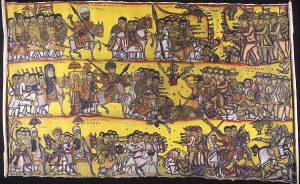Why would adults in Salem, Massachusetts in the 1690s take the accusations of nine year old girls seriously? During the seventeenth century, New England had grown diverse. The people living in the communities were of different backgrounds. But in the 1690’s there was an apparent outbreak of witchcraft. The most famous of these outbreaks was the event in Salem, Massachusetts in 1692 that stirred up the Salem community and soon spread to other communities.
The widespread hysteria over witches was all over the town after an accusation of witchcraft was made in January 1692. A group of young adolescent girls met in the home of Samuel Parris, a Puritan pastor in Salem. The pastor had a nine year old daughter, Betty. Betty and her cousin Abigail were fascinated by the voodoo tales and tricks told to them by the family slave. The family slave, Tituba, was the one whom the little girls had sought after for entertainment.1 It was not long after their time spent with Tituba, when the girls began to behave strangely; seeing visions, babbling at times, and lapsing into trances. The Puritans thought that these behaviors were of witchcraft, as the work of the devil. People in Salem began believing the girls, and charged Tituba and two other village women for practicing witchcraft on them. Two men, John Hathorne and Johnathan Corwin of Massachusetts, were called to do a legal examination of the women. The Puritans followed the Old Testament law. This was how they assessed the examinations. Scripture had a statement that said witches were not able to live. The two men knew exactly what they had to do. The examination was done on these women of Salem by looking for a certain mark on the body: a wart or tit. This specific mark was said to be the place where the devil and his demons would take blood out of the witch.2 Many of the women accused were of lower status in the community.

Research shows most of the accused witches were middle-aged women, widowed, with few or no children. Also, if the woman had been involved with domestic conflicts, they were accused. The women were accused of crimes and appeared to be dangerous by their neighbors. Women in Salem who inherited or possessed land were also accused of witchcraft.3 The accusations towards these women were out of the ordinary and seemingly wrong. One must first think about the view of women during this time. They were undermined and portrayed as having no power or knowledge of such things; they were subservient to the men in the community. Not only were low class women accused of witchcraft, but as time passed, superior women were accused as well.4
On October 29th, the Salem Witch Trials were called to an end. Governor Phips dismissed the Court and that marked the end to the witch hunt craze. Many were disappointed about the ending of the trials, but many were glad to return to work.5 The community in Salem blamed Pastor Parris for letting the innocent die. The people of the Salem church also voted to void his salary. In the following years, those family members of the deceased were restored their good names. The families were awarded a compensation for all the financial loses they went through during such tragic times. Increase Mather, a pastor of the Boston Puritan Church, wanted the people to do away with the court because he believed they put innocent people to death.
The Witch trials took on an important role in American History. The trials became a tragic and memorable moment in history. Generational, racial, and sexual hostility, opposition to law, social stresses, and food poisoning were all causes as to why the people had anxieties that found release in the witch hunt craze. The witch hunts became searches for scapegoats; the community leaders were looking for anyway possible to ease the community’s anxieties.6
- Kenneth P. Minkema, “In the Devil’s Snare: The Salem Witchcraft Crisis of 1692,” The Christian Century, no. 8 (2003): 37. ↵
- Salem Press Encyclopedia, January 2015, s.v. “Salem Witchcraft Trials,” by Warren M. Billings and Kimberly Manning. ↵
- Alan Brinkley, American History, 15th ed., vol. 1: to 1865 (2 Penn Plaza, New York, NY 10121: McGraw Hill Education, 2015), 86-87. ↵
- Salem Press Encyclopedia, January 2015 s.v. “Salem Witchcraft Trials,” by Warren M. Billings, Kimberly Manning. ↵
- Salem Press Encyclopedia, January 2015 s.v. “Salem Witchcraft Trials,” by Warren M. Billings, Kimberly Manning. ↵
- Salem Press Encyclopedia, January 2015 s.v. “Salem Witchcraft Trials,” by Warren M. Billings and Kimberly Manning. ↵



178 comments
Sabrina Drouin
Very interesting topic, the Salem witch trials have always been an interest to me. I feel like the exploitation of powerless women in this time has never been covered enough and I like that you included that the accusation of these women was out of the ordinary and plain wrong. I never knew about the compensation to the families that had someone hanged for witchcraft and I think that is also very interesting considering they were probably compensated by the same people who were accusing. Anyways, I love this article!
Trenton Boudreaux
What I find especially ironic about the trials is how an individual would seek to escape death. Essentially, if you confessed to be guilty of witchcraft, you were let off the hook, especially if you were able to name other “witches.” I found this article to be a nice retelling of the story of Salem. I especially appreciate the information about the events after the trials as I never heard much about them before.
Carlos Hinojosa
I didn’t know that not long after the craze that people realized that they were wrong and decided to pardon the names. I just assumed they just didn’t care about the dead and just moved on with their lives. Besides that it was a really well made article and I was able to follow along pretty easily while still getting the main message of the article. Great Article and great read.
Christopher Metta Bexar
Tomas Salazar was so right in his comment about the article . The witch trials according to most historians turned out to be a hoax or a way of the Puritans in the township of Salem to control women as well as thumb their collective noses at the wealthier and more established communities of Cambridge and Boston.
But what is truly scary about the women and men accused is what the article states. It was women who dared to defy society of that time along with men who had created enemies in the “ruling” families of Salem who were accused. It was considered either hysteria or greed as the real causes of the trials. And the original accusers recanted what they claimed.
Aaron Onofre
It is crazy to think that start of the Salem Witch Trials was because of two little girls. The story of these girls caused a mass hysteria and death of many innocent woman murdered based off of false accusations. These girls could have been telling the truth or just going along with a story they had created. I believe the rash decisions of the community is largely responsible for the death of these women.
Elliot Avigael
The Salem Witch Trials are incredibly interesting, and I don’t think they get studied nearly enough as they should. We laugh about witches and sorcery now, mainstreaming it into Halloween costumes, pop culture, and even films (I think of Wizard of Oz, for example); but it strange to think about how this concept of your stereotypical “witch” actually had a very brutal and unfortunate beginning. I find it intriguing how you included the fact that the Puritan leaders were actually held accountable by their community, resulting in the victims and their families being compensated generations later. There’s no doubt that there are people out there that practice the dark arts, but this wasn’t it. This was obviously a power grab by the Puritan leadership in order to instill religious fear in the populace, particularly women.
Skyla Bonilla
I was interested in reading the articles because I think reading about the salem with trials is cool, however I learned that it was a very sad time. Many women especially those of lower class were accused of performing witchcraft, committing crimes, and being dangerous people. It seems as though they weren’t even tried for something true, that they were only accused because they were women. The author did a good job of showing how unfair this time in the world was, especially to women.
Tomas Salazar
The Salem Witch Trials was one of the most horrific times of the colonial era. The article perfectly shows how women were mistreated in the puritans society. Women back then were in extreme danger, if a man did not like her for some reason or wanted to just kill her, the man could just accuse the women of witchcraft, then the women would be burned alive at the stake. It is truly disgusting of the injustices that happened to women back then. This dark time in history led to the death of hundreds of innocent women.
Perla Ramirez
This was a great article and it informed me of the witchcraft that was happening in the 17th century. All because of the child from a pastor witchcraft was a an outbreak. They ruined many lives by talking about witchcraft and even imprisoned there house slave. Many of the people that were accused were women of lower class with little to no kids. They were also seen as threatening to the society.
Maria Luevano
the Salem Witch Trials were a hard time for women, and to blame a woman to practice witchcraft when they can barely get an education makes you wonder how they could have even learned to practice witchcraft in the first place. This article highlights the importance of separating political and religious matters. Many innocent people died because of the church ordering them to be killed. This is extremely wrong and the church made some questionable decisions during this time.